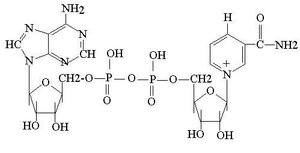Nicotinamide adenine dinucleotide
|
|

Nicotinamide adenine dinucleotide (NAD) and nicotinamide adenine dinucleotide phosphate (NADP) are two important coenzymes found in cells. NADH is the reduced form and NAD+ is the oxidized form of NAD.
NAD is used extensively in glycolysis and the citric acid cycle of cellular respiration. It forms NADP with the addition of a phosphate group to the 2' position of the nucleotide through an ester linkage. NADP is produced in the preliminary cycles of photosynthesis, and is used in the later Calvin cycle of photosynthesis. It is used in many other anabolic reactions in various organisms as well, such as fatty acid synthesis.
- MH2 + NAD+ → NADH + H+ + M: + energy, where M is a metabolite.
Two hydrogen ions (a hydride ion and an H+ ion) are transferred from the metabolite. Two electrons are transferred to the positively charged nitrogen, and one hydrogen attaches to the carbon atom opposite to the nitrogen.
See also
References and external links
- NAD and NADP (http://users.rcn.com/jkimball.ma.ultranet/BiologyPages/N/NAD.html)
- Nicotinamide (http://www.greatvistachemicals.com/pharmaceutical_intermediates/nicotinamide.html)de:Nicotinamidadenindinukleotid
